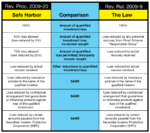The Top Three Factors to Consider When Claiming a Theft Loss Deduction
In this Report #2, we dive deeper into the phrase “reasonable prospect of recovery” and its importance in determining the timing of theft loss deductions. Learn about the origin of this phrase and how it affects the real economics of recovery.
“Report #2” from Richard S. Lehman, is a comprehensive guide to understanding the phrase “reasonable prospect of recovery” and its importance in determining the timing of theft loss deductions. The report provides a detailed analysis of the legal principles and court decisions that have shaped the interpretation of this phrase, as well as practical guidance for taxpayers and their advisors.
The first important point to note is that the phrase “reasonable prospect of recovery” is a key factor in determining the timing of theft loss deductions. According to the report, taxpayers are generally allowed to claim a deduction for a theft loss in the year it is discovered. However, if there is a reasonable prospect of recovery, the deduction must be delayed until the year in which it becomes clear that no recovery will be made. This means that taxpayers must carefully evaluate the likelihood of recovery before claiming a deduction for a theft loss.
The secondly, the determination of whether there is a reasonable prospect of recovery is based on a number of factors. The report notes that courts have agreed on several principles that provide guidance in this area. These include the need to be practical and aware of the individual facts of a case, the importance of examining both objective and subjective factors, and the need to consider the taxpayer’s legal rights as of the end of the year of discovery. Taxpayers and their advisors must carefully evaluate these factors to determine whether there is a reasonable prospect of recovery.
Perhaps the most important point is that effective tax planning for theft loss deductions requires the involvement of multiple advisors. The report notes that the tax planning should result in a professional work product that will most likely accompany an amended return or similar type of IRS filing. This work product should consist of at least three of the client’s advisors: an accountant or an accountant specialized in this area, a tax attorney, and litigation counsel. The litigation lawyer will be necessary to analyze avenues of recovery and litigation claims, while the tax lawyer will need to coordinate all of the matters in light of the taxpayer’s objectives and various legal standards that will need to be met to achieve those objectives.
In conclusion, “Report #2” from Richard S. Lehman, is an essential resource for taxpayers and their advisors who are seeking to understand the phrase “reasonable prospect of recovery” and its importance in determining the timing of theft loss deductions.
Valuable information to consider:
- What is “reasonable prospect of recovery”? There are no fixed rules for defining “reasonable prospect of recovery,” but it can be understood by reviewing court statements and general principles.
- Why is it important in determining theft loss deductions? It’s important because it determines when a taxpayer can claim a deduction for theft losses.
- What are some key factors to consider? Key factors to consider include the probability of success on any claims brought by the taxpayer, and whether there is a reasonable prospect of recovery at the time the deduction was claimed.
- Read full report on the “reasonable prospect of recovery” now: https://www.lehmantaxlaw.com/report2-ftx-ponzi/
Don’t Let Ponzi Schemes Defeat You: Claim Tax Refunds and Move Forward







